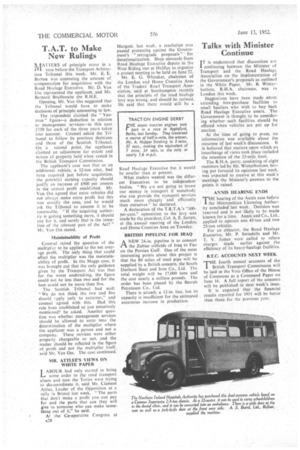T.A.T. to Make New Rulings
Page 30

If you've noticed an error in this article please click here to report it so we can fix it.
MATTERS of principle arose in a case before the Transport Arbitration Tribunal this week. Mr. E. E. Burton was contesting the amount of compensation for acquisition with the Road Haulage Executive. Mr. 13. Van Oss represented the applicant,and Mr. Bernard Braithwaite the R.H.E.
Opening, Mr. Van Oss suggested that the Tribunal would have to make decisions of principle amounting to law. The respondent claimed the "Yeoman" f.gure—a deduction in relation to management services—in this case f_750 for each of the three years taken into account. Counsel asked the Tribunal to follow its previous decisions and those of the Scottish Tribunal. On a second point, the applicant claimed an adjustment for extent and nature c.f property held when vested in the British Transport Commission.
The applicant's case was that as an additional vehicle, a 12-ton oiler, had been acquired just before acquisition, the potential earning capacity should justify an increase of £900 per annum in the annual profit established. Mr. Van Oss agreed that extra vehicles did not always make extra profit bui this was usually the case, and he would ask the Tribunal to assume it to be reasonable. " If the acquiring authority is getting something more, it should pay for it, and surely that is the intention of the relevant part of the Act? " Mr. Van Oss stated.
Maintainability of Profit Counsel raised the question of the multiplier to be applied to the net average profit. The only thing that could affect the Multiplier was the maintainability of profit. In the Maggs case, it was brought out that the only guidance given by the Transport Act was that for the worst undertaking, the figure could ruin be less than two and for the best. could not be more than five.
The Scottish Tribunal had said: "We do not think the two and five should epply only to extremes," and counsel agreed with this. Had this rule been established or just tentatively mentioned? he asked. Another question was whether management services should be allowed to enter .into the determination of the multiplier where the applicant was a person and not a company. These services were either properly chargeable or not, and 'the -matter should be reflected in the figure of profit and not the multiplier itself. said Mr. Van Oss. The case continued.




















































































